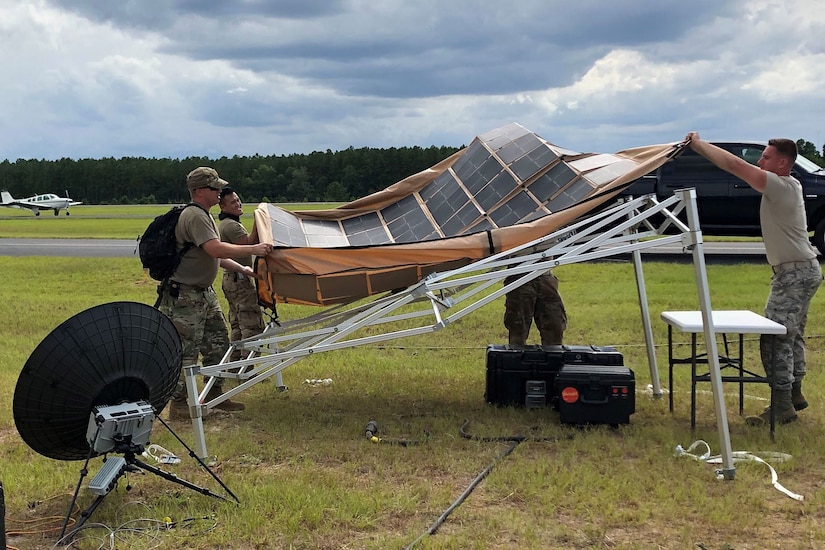June 2, 2021 | , DOD News
Secretary of Defense Lloyd J. Austin III has said there is little that the department does that isn't impacted by climate change. The President's Fiscal 2022 Defense Budget Request reflects that reality.
Droughts, wildfires, sea level rise, increasing numbers of destructive storms and more are concerns for DOD. "If you think about what generates missions, we know that extreme weather events … are affecting conditions on the ground in lots of places around the world," Joe Bryan, DOD's senior climate advisor, said.

The Defense Department must take climate change under consideration in forming strategy, conducting operations and buying equipment and capabilities. In one of his first executive orders, President Joe Biden said climate change will be a fundamental part of national security planning.
From Africa to the Middle East to Central America, the impacts of climate change are already being felt, Bryan said. Climate events can affect millions of people and challenge the abilities of local governments to respond. Mass movements in the Americas, across the Mediterranean, in the Horn of Africa, and in other areas are contributing to instability. Bryan said such movements can feed criminal and terrorist networks that find displaced people either to exploit and abuse or recruit.
Bryan said climate change is also a factor in relationships between the U.S. and its near-peer competitors. Changes in the Arctic, sea level changes in the South China Sea and temperature changes in the oceans create new challenges for the U.S., allies and partners to face, Bryan said.
DOD installations are vulnerable to climate change, and Bryan pointed to the almost $4 billion in damage to Tyndall Air Force Base, Florida, from Hurricane Michael in 2018 and the extensive damage to Pensacola Naval Air Station, Florida, from Hurricane Sally in 2020, as just two examples.
In addition, flooding along the Missouri River and waterways at Offutt Air Force Base, Nebraska, caused more than $500 million in damage in 2019 and will take years to repair. Marines at Camp Lejeune, North Carolina, estimate that the almost 900 buildings damaged by Hurricane Florence in 2018 will require about $3.5 billion to repair. Wildfires are a problem in California and much of the west affecting Camp Pendleton, California; Fort Carson, Colorado; and other bases.

But it doesn't require a storm to affect the mission. The number of high temperature "black flag" days at Fort Jackson, South Carolina — a major Army training base — cuts into training efforts, Bryan said.
Improving the resilience of these bases to extreme weather events is critical, Bryan said. "The things we do to improve resilience to extreme weather events, which we're clearly facing, will also have payouts for things like cyber attacks," Bryan said. "We rely on public infrastructure a lot, whether it's water systems or electrical systems, so you have to figure out ways in which to improve the resilience of your military base and the critical functions [and] the critical missions that are run out of there."
Bryan said one way to do this is to become extremely energy efficient. "One of the best building blocks of energy resilience and facility resilience is not demanding as much from the system," he said.
Solar power and other forms of distributed generation are also key, and so is energy storage inside the fence line of bases close to the critical infrastructure where it is needed. "If you lose the commercial grid, you are more resilient and can continue the mission," Bryan said. "They also happen to be quite good for the climate."
These things — energy and water efficiency and distributed generation — can reduce logistic support and are also increasingly cost competitive. "The prices and the competitiveness of those products just now are far, far ahead of where we were five, six years ago," Bryan said. "Battery prices have fallen by … 90 percent, and they're more efficient.
"Ford just announced last week that they're going to build an electric F-150 [pickup truck]," he said. "There's going to be over 100 … electric vehicles on the market in the next couple of years. The market has made the decision that electrification of the transportation sector is the reality ... And we as a department need to recognize that we're not going to change the trajectory of that. We need to make sure we're positioned to capitalize on the operational benefits of electrification … and that our installations can actually support a non-tactical fleet of the future."

Bryan said the military is looking to leverage this new reality. "In the budget, we're getting into some really interesting programs like hybridization of combat vehicles," Bryan said.
Electric tactical vehicles can have advantages — silent watch, low heat signature, sprint speed and fewer logistical needs. The logistics are key because reducing the need for fuel and other lubricants means fewer vehicles are needed on the road, and that creates fewer targets for an enemy. "There are all kinds of combat-related benefits you can gain from really taking on new technologies that are now not hypothetical, but are commercial," he said. The fiscal 2022 Defense Budget Request is only the start, Bryan said.






No comments:
Post a Comment